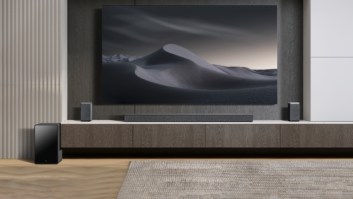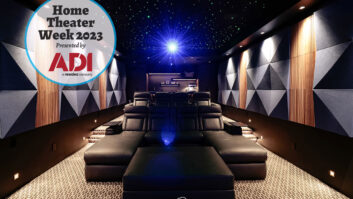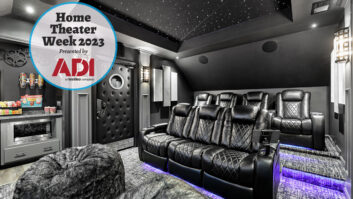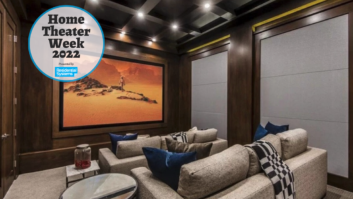On November 17, Dolby Laboratories unveiled Dolby Cinema at 1275, the newest and largest of more than 100 working labs at Dolby’s San Francisco headquarters. I was fortunate enough to attend a Dolby Cinema Master Class at the new lab, followed by the world’s first screening at the newest Dolby Cinema.

Dolby 1275 Building
Located at 1275 Market Street in downtown San Francisco, the Dolby building encompasses 68,000 square feet and features mixing rooms for work in Dolby Atmos and Dolby Vision. The Dolby Cinema at 1275 is designed as the archetype of a Dolby Cinema Theater. Dolby’s senior VP of Cinema Business Group, Doug Darrow, explained there are three main components of a Dolby Cinema. First is a Dolby Vision projection system capable of delivering the ultimate cinematic visual experience. Second is a fully immersive Dolby Atmos speaker array. And finally is something Dolby calls an “inspired design” that is meant to transport viewers into another space to be fully absorbed in the cinematic experience.
Building the company’s latest state-of-the-art lab/theater in downtown San Francisco required significant work to ensure the theater’s acoustics were isolated from the noise and vibrations of noisy downtown San Francisco. Built just above a BART (Bay Area Rapid Transit) station, engineers achieved the theater’s recording-studio-silent NC15 rating by utilizing a room-within-a-room design.
The cinema features five-foot-thick walls with an 18-inch air gap all around, meaning no external noise or vibrations disrupt the presentation and that the space is significantly quieter than virtually any other movie theater in existence. The room features 12 layers of sound deterrence and includes six different types of acoustic treatments with approximately 1,400 treatments in all. To further reduce noise, the HVAC system was designed with vents located under the seats. These registers are not only invisible to viewers, the system releases air slowly into the room to avoid making any noise.

Dolby Cinema Entrance
While it’s not a commercial theater, the new Dolby Cinema is a place where Dolby technicians will develop the next generation of revolutionary imaging and sound technologies. These include Dolby’s latest achievements including Dolby Vision High Dynamic Range laser projection and studio-grade Dolby Atmos immersive audio. The theater also provides a place where visitors can experience what Dolby does.

Theater Wall Entrance
Everything about the new cinema is meant to enable spectacular experiences, and this begins with the cinema’s entrance, which creates an audio/visual pathway to transport viewers into the story like never before. The entry video wall is 15 meters long, and features ultra short-throw laser projectors and 7.1-channel surround audio to introduce and invite viewers into the space, raising excitement for the presentation before people even step foot into the theater.

Dolby Cinema Inside

Dolby Amp Racks Once you enter the theater space it is instantly apparent that you have stepped into a special environment. The theater’s primary color is black, designed to absorb any light reflections and maximize video contrast, with blue accent lighting that highlights the walls and screen prior to the film’s beginning.
Part of the “inspired design” is having nothing that detracts from the magical experience. This includes having no visible speakers within the theater; instead, all 57 studio-grade Dolby Atmos speakers are concealed by acoustically transparent fabric.
The theater’s focus is the massive 50-foot-wide screen, and all 237 seats are positioned for optimal sight lines. All rows are curved, and every seat is ideally pitched and angled to the screen for the most comfortable viewing experience.
All of the theater’s electronics are housed in the temperature-controlled projection room, with racks filled with amplifiers and electronics. In addition to showing films, the cinema can also host live events, such as performances and seminars, and its Meyer Sound Constellation system can tailor the room’s acoustics to fit the live presentation.
Dolby Atmos Processors
The studio-grade Dolby Atmos sound system and dual CP850 Dolby Atmos processors handle audio for the 57 speakers, allowing filmmakers to precisely place and move sound all around the hemisphere of viewers, including overhead.
Darrow describes the Dolby co-designed and custom-built Christie Laser projectors as “quantifiably higher performance than any other technology out there,” and the Dolby Cinema utilizes two of them to maximize light output and contrast.

Dolby Laser Projectors
These projectors use state-of-the-art optics and image processing to deliver HDR images unlike anything you’ve ever experienced. With 31-foot lamberts on screen, these projectors deliver twice the brightness of a typical cinema projector. Even more impressive, with 1,000,000:1 contrast, they have 500 times the dynamic range of typical cinema projectors, and deliver the lowest black level of any commercial projector.
To demonstrate just how staggering the contrast is, Dolby developed a “White Dot” test. With this, a large white dot is projected onto the center of a black background. The projectors are put into an emulation mode to show what a traditional projection system looks like, and the screen is a dark gray. Then the projectors are put into high-performance mode and the screen takes on an OLED level of blackness with the white dot exploding off the screen with massive light output. The group of press I was with literally gasped at the demonstration.
The projectors also deliver an incredibly wide color gamut, getting closer to the Rec.2020 color space than any other projector. They are also capable of supporting high frame-rate (HFR) films such as Ang Lee’s Billy Lynn’s Long Halftime Walk, which was shot at a Hollywood-first 120 frames per second.

Dolby CEO
The evening’s highlight was the world premier screening of Star Wars: The Force Awakens in Dolby Vision 3D. And, let me assure you, the picture and sound quality were every bit as awesome as you’re imagining. The theater’s bass was incredibly tight and deep, and the 3D popped off the screen aided by the massive light output of both laser projectors. I have seen films in some incredible theaters before, including The Stag at Skywalker Ranch, and this was the best cinema experience I have ever had.
Before the film began, Dolby’s president and CEO, Kevin Yeaman, came out to say a few words and to officially open Dolby’s latest lab to the world. Also on hand was Ben Rosenblatt, co-producer of The Force Awakens, who shared some interesting anecdotes about the film’s production, as well as working with Dolby Vision and Dolby Atmos.

Dolby with R2 and C2-B5
Following the event, some special guests were on hand. Here’s a picture of me with R2-D2 and C2-B5 from the upcoming Rogue One film.
The 50th Dolby Cinema screen is expected to go live this week, and there are approximately 300 Dolby Cinema screens currently under contract. AMC is projecting to open 100 screens by the end of 2017, and 160 by 2018.







